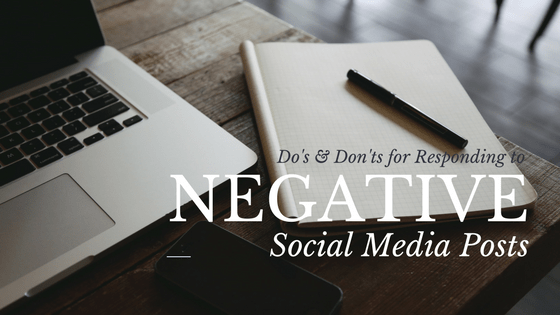The 4 Do’s and Don’ts for Responding to Negative Social Media Posts

Social media is still the wild wild west of the internet, making it especially complex for businesses of any size. Having a strong and useful social media presence is necessary for companies to thrive, but that’s no easy task. Negative social media posts are inevitable (there are even guides for how to be a person who excels at negative social media posts), regardless of how great your company is. Mastering the art of responding to those negative posts can be the make or break to thriving on social sites, so we put together these simple do’s and don’ts to follow.
DON’T ever, ever delete negative comments EVER
Have you ever heard the saying, “That says everything about you and nothing about me”? Let that ring true here. If someone posts a very negative social media post, do not delete it. That already unhappy person will come back furious, and with a vengeance, because deleting her comment means your organization took away her voice when she wanted to be publicly heard.
It takes guts to let negativity be publicly associated with your organization, and gone are the days where Suzy called all her friends around the block to tell them about her awful experience with you. Now, Suzy has hundreds, if not thousands, of Facebook friends to share her experience with, and your company has hundreds, thousands, even millions of Facebook fans that can see Suzy’s issue when she posts it to your page. That’s the reality of our world now, so let Suzy share her grief while you focus on what you can do about it (see number 2).
DO control what you can
Whenever appropriate, direct the conversation offline. There are a lot of uncontrollable possibilities on social media, so if your organization has the opportunity to take the conversation offline, do it. The last thing you need is to air your dirty laundry for all the internet trolls to follow, and that is exactly what you’ll do if you try to resolve an issue with an unhappy keyboard warrior in the public eye.
When someone chooses to use social media to express their unhappiness or file a complaint with your company, your organization has no control over that. Being present on social is a necessity, but it makes you a sitting duck. When someone shares their disdain for the entire internet to see, take control. Craft your response to make him feel valued and heard, and ease his issue by providing a solution that’s quick and simple for the customer. A 1-800 number might be convenient for your company, but it’s a pain for an unhappy customer.
Take this response into account:
“Hi John – I’m sorry to hear that X happened to you. That is not acceptable by our standards, so thank you for bringing the issue to our attention. What is the best way to reach you? Please PM us your personal email or phone number, and [insert name of applicable staff member] will reach out to resolve this ASAP.”
- We acknowledged John’s complaint and validated his feelings
- Our team admitted that what happened was not acceptable to the company either
- We took the conversation offline, and let him know a specific person would be contacting him the way he preferred
- Our staff didn’t use a canned response that could make John feel unimportant
The way you structure the message to take the conversation offline is important. Because the internet world has (potentially) already seen the complaint, simply saying “PM us your email” won’t cut it. You need to be human, sympathize with your unhappy customer, and reasonably work toward a solution…and the social media world needs to see your organization do that. If they don’t, they will jump to conclusions, and your company will find itself in battle with more keyboard warriors.
DON’T let the negativity go too far on your company page
In the United States, Freedom of Speech is one of your main constitutional rights. But when it comes to your company’s social media sites, there is such a thing as going too far. I highly recommend having 1-3 lines in your ‘about’ section outlining your page guidelines.
For example, DemandZEN has core values like “We communicate effectively” and “We are family oriented”. From there, we might decide our page guidelines be, “At DemandZEN, we value effective communication from our team and customers, so please feel free to give us useful feedback. We are also a family-oriented organization. Any and all discussions had here should be respectful and appropriate for all family members. If actions on this page challenge this value, we will kindly ask you to come back when you can communicate effectively.”
Making guidelines public and easily accessible gives your company power if things start to get too rowdy on social. Conversations can take a turn for the worse quickly, even if your organization is never involved. Social media lets anyone have a voice and, sometimes, that voice is beyond negative. When values, and even safety, are challenged by your audience, remind them of your guidelines. Then, ask them to come back when they can abide by them. If the problem persists and is serious, I recommend blocking the individual. Then make a public statement reinforcing your guidelines and reminding fans and followers that all feedback is encouraged. But, your company still has a duty to its core values, its employees, and its audience – above all else.
DO have a response plan
“Prepare for the worst; hope for the best”, right? In order to successfully respond to negative social media feedback, you need to have a response plan. Someone, or a team of people, must be responsible for monitoring and responding to customer complaints across all social channels. When putting together a response plan, consider including the following:
- The person(s) responding should have customer service experience and be social media savvy.
- Company resources and contacts, so the customer-facing person has what she needs to respond effectively and appropriately.
- A minimum wait-time before responding. Even with the best experience, we are all human. Give responders a period of time to digest the comments, come up with a solution, and draft a message to respond to the unhappy customer.
- A second opinion. Always have a team member read over your response before clicking ‘send’. You may have the best intentions, but after feeling that negative comment, a certain tone can shine through. Have someone less involved look over your message – it’s always a good idea. And the extra 10 minutes it takes to do that is worth it.
The way your organization responds to its audience on social sites can make or break a company and its reputation. Apply these do’s and don’ts, and you will be on track to winning hearts in the wild wild west of social media.
To take your social media presence to the next level, check out this blog for strategies your company needs to try.
You Might Also Enjoy These Posts
Demand Generation vs Lead Generation
Gamification Strategies: Badges in B2B Marketing
Welcome To DemandZEN
DemandZEN specializes in Account-Based Demand Generation and solving the challenges around finding, engaging and converting target accounts into real opportunities for B2B Technology and Services companies.


